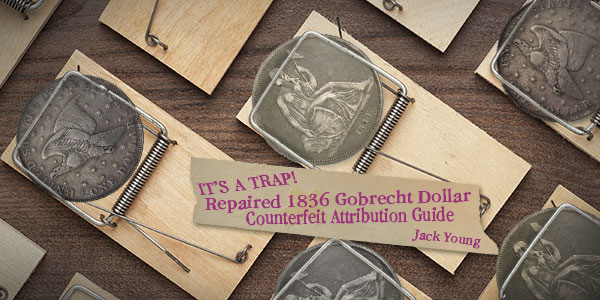
By Jack D. Young, Early American Coppers (EAC) ……
Probably one of the most significant “finds” we as a group have made is this Gobrecht dollar, and it is certainly the earliest we have seen, as the holed source coin sold in a 2008 auction. This article is intended as another installment disclosing discovered current deceptive struck counterfeits and the one-page attribution guides for each; the research continues to be a collaborative effort with many participating numismatic clubs, Facebook “Dark Side” members and friends participating.
* * *
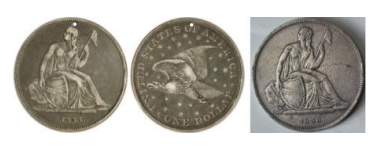
1836 Gobrecht Dollar (Images courtesy HA.com, Jack Young)
After receiving an email from one of the members of a group of apparently connected sellers I monitor inquiring if I would be interested in purchasing an 1836 dollar, I immediately went into my saved images and information from research over the last two years regarding current struck counterfeits. At the start, I focused my research and attention on the early coppers as a member of EAC but eventually refocused on other denominations and varieties. In a previously known suspicious group of a TPG submission of coins that netted many of the fake early coppers we continue to chase (images stored on the EACS.org blog site) was a questionable 1836 Gobrecht! The online cert actually stated “Grade PENDING”, and the images were still available on the TPG website for comparison to this latest offered example.
Comparing the images of both I immediately noticed common sister marks between these two apparently different examples and posted my observations on our fake and counterfeit discussion Facebook page “Dark Side”; this eventually turned into one of the longest responded posts we’ve had over there and resulted in the “discovery” of several examples with four imaged in TPG slabs. Again, the participation of the dedicated members of this group makes the research and documentation of these struck fakes a much easier task, especially with the nearly instant availability of information on the internet.
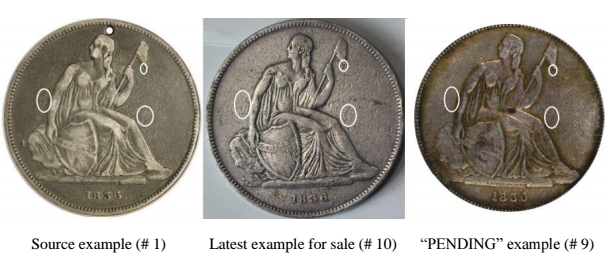
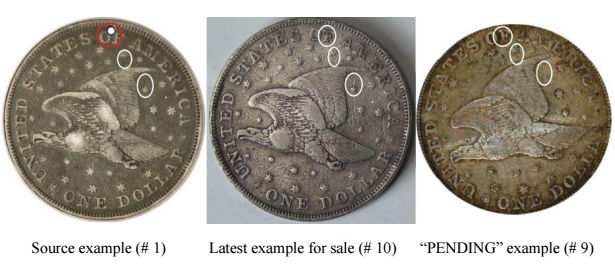
As I discussed in a previous CoinWeek article on damaged and repaired source coins, my next step is to create a “time-line”. I use this while reviewing the available subject images to help determine which came first in a logical progression in an effort to sort out the differences and duplicates among a group of possibly different and unique examples.
The resulting time-line for the researched 1836 Gobrecht dollars is as follows:
- September 2008 – NCS #5130347-002 holed example sold at auction – source
- November 2010 – Auction example (NGC Fine Details – PLUGGED) – probable repaired source
- January 2013 – Auction example (TPG VF Details Damaged) unsold
- January 2013 (same auction) – Example sold for $6,462 (TPG VF Details Cleaning)
- February 2013 – Example sold on eBay (TPG-certified) – same example as #3
- November 2013 – Example sold on Internet
- June 2014 – Example sold on the Internet (TPG-certified)
- July 2014 – Example sold in auction (TPG-certified)
- TPG-certified “Grade PENDING” rom a submission reviewed for bad early coppers
- June 2017 – Offered for sale – shipping from The Netherlands
As usual, the timeline was invaluable in this research, with several noteworthy items.
First is the number of certified/slabbed examples from two different TPGs, including the damaged and probably repaired source coin and possible duplicates; eight of the 10 sets of images were of certified examples.
The date of the auction of the damaged source of 2008 places this variety before any of the others documented so far; the 1798 “S-158” large cent went back to 2013, the 1806 “C-1” half cent to 2011.
And, I can cut to the chase pretty quickly as a result of the time-line and state there is certainly at least one fake among the group since examples #3 and #4 were in the SAME auction in 2013, described as being in two different TPG slabs as well (Lots 12492 and 13217)!
The common sister marks and uncommon circulation marks bear this out (sister marks in white, uncommon marks in red). Note: “Sister marks” are the shared marks in common with both the source and fakes struck by the transferred dies. Uncommon marks may be techniques the counterfeiters are using to disguise their “fake coins” struck with the same set of transfer dies. Common techniques include different toning, additional contact marks, changing the strength of the impression, adding additional contact marks, corrosion, etc.
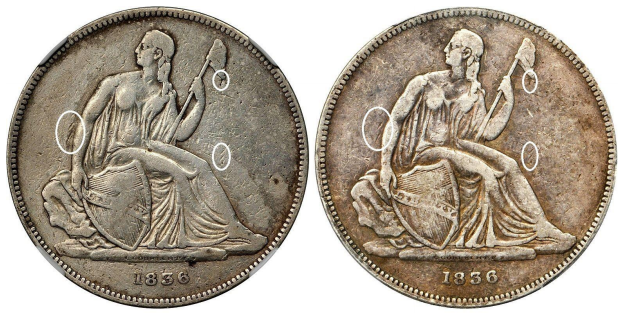
Left: 2013 Auction example (#3); Right: Same 2013 Auction (#4). Images courtesy Stack’s Bowers
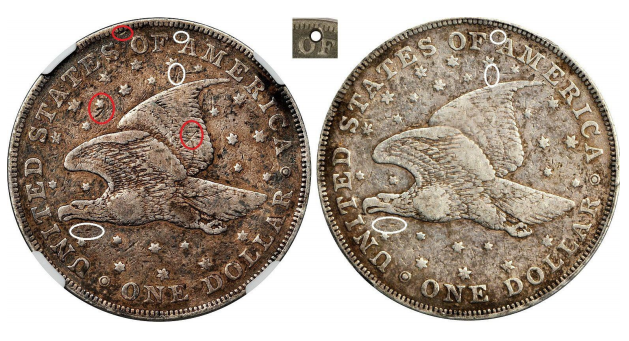
Left: 2013 Auction example (#3) reverse; Right: Same 2013 Auction (#4) reverse. Images courtesy Stack’s Bowers
Images of the genuine damaged source coin and probable repaired source are as follows:
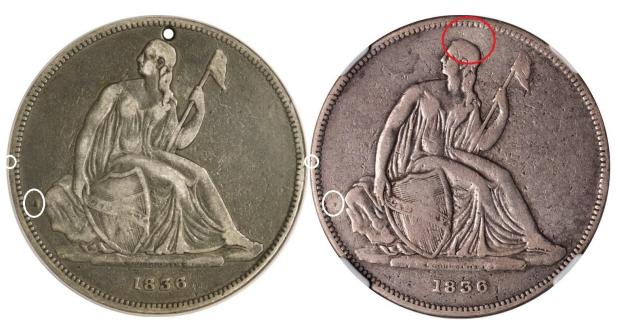
Left: 2008 Auction example (#1); Right: 2010 Auction “Plugged” example (#2)
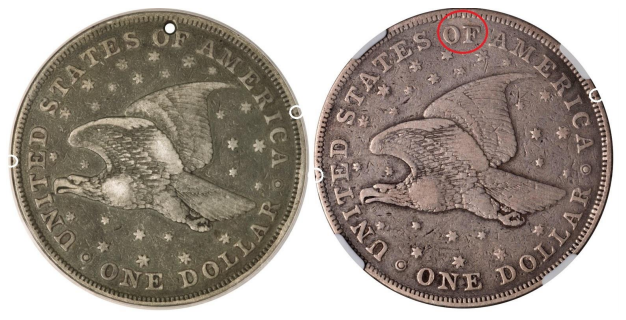
The apparent repaired source has surface marks/toning differences at the repaired areas as well as several very specific edge and surface marks common to just these two examples. They also carry the main sister marks of all examples reviewed to date, documented on the attribution page.

Left: Probable repaired source (#2); Center: Latest example for sale (#10); Right: Genuine (image courtesy PCGS)
One apparent difference is circled in red between the probable genuine repaired coin, a suspicious example currently for sale, and a known one; the indicated difference to the genuine coin is common to all of the documented suspect examples in this review (indicative of the minor repairs required due to the hole). Comments from one of the experts after review of the images:
“The apparent host coin is genuine, and 1836 striking, as it does show the “compass scribe line” in the dentils from N in UNITED to M in AMERICA. The piece also has what looks like at least one chip in the dentils below last A in AMERICA. The copy pieces are very well made as they do show traces of the scribe line in the dentils. They also show a trace of the dentil chip, although it is not the right shape. I also note that the rims appear to be way too thin for a real Gobrecht dollar and the dentil shape is off”.
The next set of images compares what appear to be additional examples:
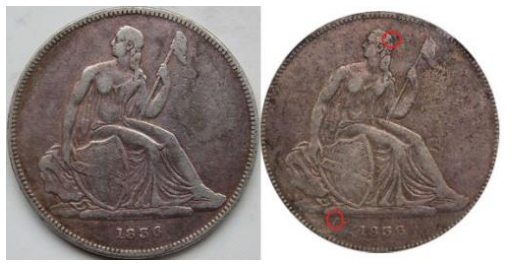
Left: Internet example (#6); Right: Certed example (#7)
These also carry the same attribution sister marks but include what appear to be uncommon marks between the two.
The next pair:

Again, they both appear to display common and uncommon circulation marks.
And the latest example to come to light:

Raw internet example (#10) 2017

Left: 2010 Auction “Plugged” example (#2); Right: Raw internet example (#10) 2017
Again the common marks are visible on both examples, while there are uncommon marks, differences in toning, and the definition of the edge borders between these two to indicate they are different examples. And the latest one was offered for sale for “$3000.00 US”, shipped from The Netherlands (the same seller as a 1795 “S-76b” large cent, but that’s another story).
It is certainly nearly impossible to tell with 100% certainty which are “live or Memorex” from images alone, but it is apparent from these sets of images that there is at least one counterfeit among them, and most probably more!
The attribution page follows.

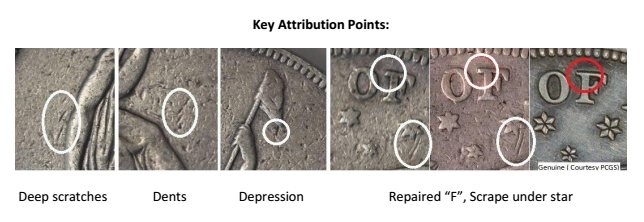
Another big thanks due to my friends on Dark Side, with a special call out for Matt D. (www.ldrcoins.com), Ashley C. and Mark K. for their contributions to the research and image analysis required for this one! I would also like to thank Saul Teichman for his review of several of the images and his including this one on his web site.
As always I hope this article is informative and gives a sense of what we as a hobby are facing; we continue the research and searching for additional examples and to develop a database with efforts to “get the word out”.
Best,
–Jack
MORE Articles on Counterfeit Coins by Jack D. Young





Jack Young if you give me your address privately I will send you a complimentary copy of my new book Forgotten Coins which discusses counterfeits from 1500-Present from around the world.It should help in your research efforts. I also discuss how to detect Modern Chinese forgeries with XRF analysis.
John, sent you the info through a FB message; thanks!
New example discovered on the internet for sale 4-2-20; TPG killed the cert and the seller ended the auction. May have saved someone $14K today…